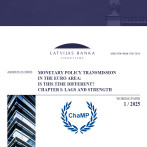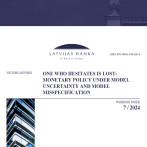Devaluation: Does the Latvian Banking System Need Shock Therapy?
Economists often refer to the so-called macroeconomic shocks, i.e. sudden and, as a rule, unexpected events that destroy the economic equilibrium. One of such shocks is depreciation or devaluation of the national currency with implications not only for households and the corporate sector but also for the core of the national economic organism, i.e. the banking system. It is true however, that heart failure results in dysfunction of the entire organism.
Those experts who are proponents of devaluation usually neglect the fact that banks and the economy as a whole, and, consequently also the nation's welfare, do not exist in parallel worlds but are closely interconnected and taken together form a single organism. Moreover, serious banking problems immediately affect people and companies both directly as depositors, account holders and borrowers, and indirectly via state budget failures and draining of program financing, discontinuation of lending, steep economic downturns, and rapidly rising unemployment rates.
Companies and population first to suffer In the event of a national currency devaluation, the economic agents (the state, enterprises, and households) whose liabilities are in foreign currencies but claims in national ones will immediately rank as losers, because all of a sudden, larger amounts of the (devalued) national currency will be required in debt repayment. Attributable to the banking sector, the banks with amounts of funding attracted in foreign currencies (e.g. the euro) larger than the invested amounts will incur additional losses. This will be a result of bank liabilities in lats (deposits, borrowings from other banks, bank's own issued securities, etc) growing much faster than bank claims (loans extended to other banks, companies, households, investment in securities and other financial instruments, etc). It should be noted, however, that for Latvia the implications of this risk are limited as bank assets and liabilities in foreign currencies are generally balanced consistently with the requirements of supervisory institutions. Nevertheless, the situation is not as simple as that. Devaluation affects the financial position of a bank primarily by shifting the borrowers' problems onto the bank's shoulders. Its first most vivid expression will be soaring loan defaults. Past due credit debts have an effect on bank positions For bank customers with loans in foreign currencies (the euro, US dollar or other) depreciation of lats will increase the debt burden and, consequently, also the respective regular amount to be repaid in lats. In percentage terms, the respective increase would be on par with the decrease in lats exchange rate against the loan currency. At the close of 2009, around 93% of all loans to residents were in foreign currencies (predominantly in euro). The borrowers have preferred loans in euro due to considerably lower interest rates. Households and domestic businesses engaged in servicing the domestic market, i.e. with their income in lats, dominate among the borrowers. This suggests that devaluation will directly affect almost all bank borrowers. A currency shock will spare only those businesses whose income is mainly in foreign currencies. Among businesses, these will predominantly be exporting companies with income from sales abroad earned in foreign currencies (see article "Devaluation: exports and imports). For population, these will be individuals who work abroad. However, the share of such companies and individuals in bank credit portfolios is insignificant. For all other borrowers, devaluation will reduce the value of disposable income and render the repayment of principal and interest increasingly problematic. The situation will be made more complicated by devaluation related processes like rising unemployment, soaring prices of goods and services, and dropping real purchasing power. As a result, the number of insolvent companies and households (families) will hike. A steep deterioration of the borrowers' financial situation resulting from a devaluation shock will bring about an increase in loan defaults of a snow-ball effect; banks at the same time will have to make specific loan loss provisions in a short span of time and to push up their capital to offset losses incurred due to non-performing loans. Ever increasing losses will "eat up" bank capital which, in turn, will present a threat to the operation of the entire banking sector. Devaluation implies a steep rise in bank losses and no time for solution seeking At the end of the third quarter of 2009, delayed loans made up one fourth of the total loan portfolio of the Latvian banks, almost doubling the figure of the third quarter of 2008. The number of loan defaults is notably accelerating as an effect from the economic downturn. At the current crisis junction, the Latvian banks have made loan loss provisions in the amount of more than a billion lats! If devaluation were to materialise in Latvia, bank losses would increase rapidly and dramatically. Even though banks actively strengthened their capital last year via additional investment (at November's end 2009 resulting in the average capital adequacy ratio of 13.6% vis-à-vis minimum permissible level of 8%) and are committed to proceed, the capital boosting potential is unlimited for none of the banks. In addition, spurred by devaluation, the bank losses may grow at an exceptionally fast pace, suggesting a pronounced shortage of time for finding fresh resources to push up capital. This may necessitate the government to step in with a repeated bail-out of banks via shifting the state budget funding (non-existent or borrowed) into bank recapitalisation or, in the case of bank insolvency, into the Deposit Guarantee Fund to make guaranteed compensation payments to depositors. Devaluation related problems drain budget and disrupt lending The adverse effects referred to above are well supported by historical occurrences in a number of world countries and regions. The Mexican banking crisis in the 1990s is one of the cases. Devaluation of peso, the national currency, by 15% on 20 December 1994 and the transition to a floating exchange rate were followed by a massive hike in loan defaults, which in combination with substantially raised interest rates made loan repayments practically impossible. At the end of 1995, past due loans in the banking sector of Mexico amounted to 36%, to climb to 52.6% a year later. In order to rescue the banking system, the government was compelled to inject additional massive funding into failing banks as well as pursue bank takeover and borrowers' support programmes. The aggregate Mexican budget expenditure on bank rescue in the crisis period was estimated at 19% of GDP (more than Latvia's education and health budget). The financial deterioration of corporate and household positions due to devaluation has been a major driver behind the economic downturn of 1997 in East Asia. Devaluation is likely to push up interest rates, a consequence of devaluation-related high inflation and uncertainty. In Mexico, inflation rose from 7% to 50% in 1995; during the 1997 crisis, a similar phenomenon was also observed in East Asian countries. Rising interest rates imply higher interest payments on loans for borrowers which, on the one hand, is an extra burden and, on the other, an obstacle to the revival of lending. The pass-through of destructive devaluation effects to the banking sector can also take place via confidence crisis. The latter may not only spur the conversion of lats deposits into foreign currency ones but also cause a massive deposit withdrawal from banks. In September and October 2008, when the wave of distrust aroused by the financial crisis rolled over Latvia, the total outflow of funds deposited with the Latvian banks exceeded 700 million lats! It is a general knowledge that in the situation of a rapid outflow of funds even the safest bank will encounter financial hardships. In the situation of a confidence crisis, the Latvian banks would be deprived of a possibility to attract additional resources as there would be no creditor eager to stand by. Even at this point due to an overall complicated global financial market situation, the ability of local banks to borrow from foreign banks is rather limited; it is only banks owned by influential foreign investors that may expect support from their parent banks. It is obvious overall, that devaluation of lats would seriously distort the operation of the Latvian banking sector. Bank liquidity (i.e. short-term resources) and capital adequacy problems would progressively limit banks' ability to proceed with financing the economy as liquidity would have become inadequate. Such a twist would favour neither banks, nor households, nor companies. Contrary to the interests of individual companies, economic players or even sectors, the Bank of Latvia treats the economy and the financial sector as a single body, relying on interconnections between the processes. From this perspective, devaluation is not only a threat to banks, it jeopardises the entire economic system of Latvia and its population.
Textual error
«… …»






